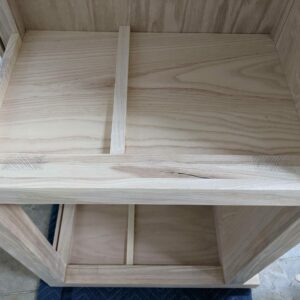Need help solving a problem, what’s the best way to do this?
Long story short – also hard to explain – I have doors with glass inserts with inset hinges that are already mounted to the doors (I screwed up) and they will not let the doors sit flat against the inside of my cabinet. The easiest way I could think of to fix my problem was to just recess an area of about 2/16″ in depth so that the hinge can sit inside of it and therefore let the door touch the inside of the cabinet and then I can adjust the hinge to create the reveal I want. I don’t have enough room to use my router, which would have been super easy to do. There’s like 1.5″ of space between the area I need to recess and the top/bottom of the cabinet. The only way I can think of would be to use a chisel and do it by hand. Is there another way that I’m not thinking of?















Replies
Razor the lines and use a small router plane. An easy pickup on fleabay, and a nice, perfectly flat-bottomed recess.
I did think about a router plane, but it's the same issue with my router because there just isn't enough clearance for it. Only 1.5" of wiggle room on the sides and router planes usually have a wide plate to support the cut.
It would probably take less time to do with a chisel than to set up machinery.
An interesting problem though - this is probably doable with a dremel router set up. I don't have one to test the wiggle but if mechanical precision is require then that would be a goer.
You could also make a small router plane using an allen key as the cutter - it does not need to stay sharp for long after all, or buy the Veritas small router plane.
I like the idea of making a custom router plane with an allen key after watching a video about it. Potentially something to make in the future.
I have a Stanley #271 small router plane, which would do this job really well, after roughing out with a chisel. There are multiple ones for sale on ebay, tho not cheap. But they are very handy; I use mine more than the full size #71. If your hinge is fairly wide and the router will fall into the opening when paring near one end or the other, leave a narrow section in the middle untouched, until you have routed the areas on both sides of it to final depth, then pare down the middle with a chisel.
If you do use a chisel, rough it out, follow your knife line along the edge to start the final depth, then use a combination square set to the final depth to check for lumps. Or a 6" ruler clamped to a block of wood.
This forum post is now archived. Commenting has been disabled